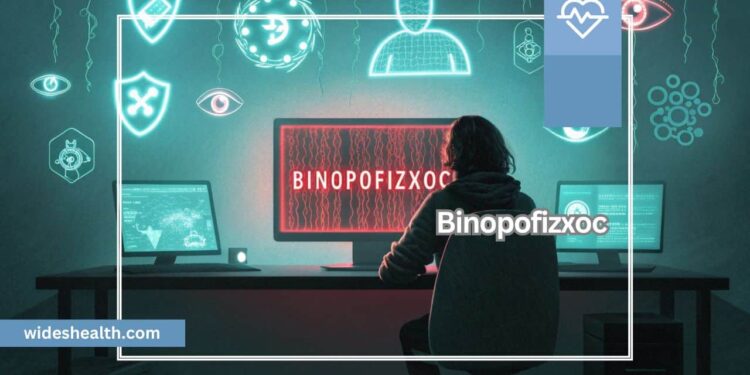In the ever-evolving digital landscape, new terms, codes, and phrases seem to appear out of nowhere, often leaving us confused and curious. One such term that recently piqued my interest was “binopofizxoc.”
At first, I couldn’t help but wonder where it came from and what it meant, especially when it began showing up in places I hadn’t expected—like my browser history and system messages. Intrigued but uncertain, I decided to embark on a journey to explore this mysterious term, hoping to uncover its significance. In this article, I’ll share my personal experience and dive into what I discovered.
The First Encounter – A Strange Term in My Browser!
It all started when I noticed “binopofizxoc” appearing in my browser history. I wasn’t actively searching for it, but there it was — lingering in the background of my web activity. At first, I brushed it off, thinking it was just another one of those random strings that occasionally pop up in URLs or software code.
But curiosity got the better of me. I Googled it. The results were not what I expected. There was a mix of discussions, some from tech forums, others from cybersecurity blogs. “Binopofizxoc” seemed to be everywhere but nowhere at the same time. It wasn’t a well-known term, yet it appeared to be on the radar of many people, particularly those in tech and cybersecurity circles.
What Is Binopofizxoc?
When I started digging deeper, I found that “binopofizxoc” didn’t have a clear definition in traditional dictionaries or well-established digital references. Instead, it was likely a modern term generated by either a system, software, or a machine-learning algorithm.

The fact that it wasn’t recognized immediately made it even more intriguing. Its unexpected appearance in my digital space added to the mystery. It could be a virus, a project name, a temporary code used by a developer, or perhaps even part of a hidden feature in the software I was using. The possibilities seemed endless.
Theories Behind Binopofizxoc:
After some digging, I came across several possibilities:
- A Software or AI Project Name: It could be a random name used internally by a software company for a project or feature. I’ve seen it happen in tech companies that often generate random codes or names for testing or internal purposes. Maybe it’s a project label or feature hiding in plain sight.
- A Malware or Spyware Component: As a cybersecurity enthusiast, I considered the possibility that “binopofizxoc” could be associated with malicious activity. Cybersecurity experts often encounter strange terms like this in malware scripts or phishing attempts. However, after scanning my device thoroughly with trusted antivirus software, nothing suspicious was found.
- A Machine-Learned Word: AI systems today are capable of creating unique word combinations, which are sometimes used for training or testing. Could this be one of those randomly generated terms? It’s possible. AI language models create bizarre terms for testing purposes, and maybe “binopofizxoc” was one such experiment.
- A Code Snippet or Configuration Key: Developers often use autogenerated names or random strings as code snippets, configuration keys, or API tokens. The term could simply be an identifier hidden in some code, unrelated to anything harmful.
My Approach – Should I Be Worried?
When I saw “binopofizxoc” for the first time, I felt a bit of anxiety. It’s natural to be worried when something unfamiliar shows up on your device. Here’s what I did to put my mind at ease:
Stay Calm:
When I first encountered “binopofizxoc,” anxiety set in. However, I reminded myself that unfamiliar things don’t always pose a threat. It’s easy to panic with new tech, so I decided to stay calm, breathe, and research more thoroughly before jumping to any conclusions about its significance.
I Did a Deep Search:
I searched “binopofizxoc” across tech forums and blogs. Many developers had encountered it, especially in software development environments. Though not dangerous, most sources advised caution. It seemed like a random term linked to software, likely generated during coding or development. It wasn’t harmful, but I remained cautious.
I Scanned My Devices:
To be sure, I used Malwarebytes and Kaspersky to scan my devices for potential viruses or malware. Fortunately, no threats were found. This brought relief, ruling out the possibility that “binopofizxoc” was harmful. It wasn’t causing any immediate issues, but I kept monitoring my system just in case.
Consulting an Expert:
I contacted a tech-savvy friend for advice. He explained that strange terms like “binopofizxoc” can appear in the background of systems, particularly in beta software or experimental features. It was likely internal code that accidentally surfaced. He reassured me that it wasn’t a serious problem and didn’t require immediate action.
Also read: Networkfinds How Hhc Vaping Affects Creativity And Focus – Boost Your Brainpower Today!
How I Dealt With It – Practical Steps?
I found it helpful to follow these practical steps to ensure my safety:
- I Updated All My Software. Software updates are crucial for protecting against vulnerabilities. I made sure my system and apps were up to date, ensuring that any potential security issues were patched.
- I Avoided Clicking on Unknown Links. “Binopofizxoc” appeared in some suspicious links and emails, so I was cautious about where I clicked. I always checked the link with a trusted URL checker before opening any link associated with it.
- I Used a Stronger Password. While “binopofizxoc” didn’t appear to be a direct threat, I knew that using strong, unique passwords was aan important part of my overall digital safety. I updated my passwords for added security.
- I Kept Calm and Monitored the Situation. The key to handling unfamiliar terms or situations like this is monitoring. If I noticed “binopofizxoc” again, I would perform another scan and stay vigilant, but I wouldn’t overreact.
Possible Meanings Behind Binopofizxoc:
A Hidden Software or AI Identifier:
Tech companies often generate random names for internal projects. “Binopofizxoc” could be a beta-testing module, an experimental AI algorithm, or a placeholder for an upcoming feature. Such terms are common in development environments where early versions are being tested and refined before public release.
A Cybersecurity Threat:
Malware often uses obscure names to evade detection. “Binopofizxoc” could represent a malicious script, a command-and-control server tag, or a phishing link component. Cybercriminals often hide such identifiers within code, making it harder for antivirus software to identify and block potential threats to users’ systems.
A Machine-Generated Term:
AI models sometimes generate random or nonsensical words. “Binopofizxoc” might be a test case in language processing, or it could result from a glitch in automated naming systems. As AI continues to develop, such terms may appear during experiments, showcasing the unpredictable nature of machine-generated outputs in evolving technologies.
A Code or API Element:
Developers often use random strings like “binopofizxoc” as temporary variables, API keys, or debugging markers. These placeholders are crucial during development phases when code needs to be tested or restructured. They are often removed or replaced once the project reaches its final stages, serving as functional elements rather than final features.
Also read: Antonia Derramas Licensed Mental Health Counselor Associate – Real Stories, Real Results!
How to Handle Unknown Terms Like Binopofizxoc?
Stay Calm:
When encountering unknown terms like “binopofizxoc,” it’s essential to remain calm. Unfamiliar terms often appear in technology, but that doesn’t mean they’re dangerous. Panicking can cloud judgment, so take a deep breath and approach the situation logically. Staying calm allows for a more methodical investigation into the term.
Investigate Deeply:
To understand unfamiliar terms, research thoroughly on trusted tech forums like Stack Overflow or Reddit. Searching for the term in cybersecurity blogs or developer communities can reveal more context. Often, others have encountered the same term and can offer insights, helping you identify whether it’s harmless or a potential concern.
Run a Security Scan:
Use reliable security tools like Malwarebytes or Windows Defender to check your devices for potential threats. These scans can help identify if the term “binopofizxoc” is linked to malware or malicious software. Running regular scans ensures your devices remain secure and provides confidence that the threat is harmless, not a threat.
Consult an Expert:
If you’re still unsure, consult an IT professional or developer for advice. Experts have the technical know-how to assess unfamiliar terms and their potential risks. By getting their perspective, you can determine whether the term is benign or if further action is needed, ensuring your system stays secure.
Is Binopofizxoc Linked to Hacking?
There is no direct evidence linking “binopofizxoc” to hacking, but it’s important to remain cautious. Cyber threats often involve unfamiliar terms, and while “binopofizxoc” may not be harmful, it’s still wise to take preventive measures.
Avoid clicking on unknown links, keep your software up to date, and use strong, unique passwords for all accounts. By practicing good cybersecurity habits, you can reduce the risk of falling victim to potential threats, even if the term itself doesn’t directly indicate malicious activity.
Also read: Memotohinnoahanol – Achieving Balance And Mindfulness!
Common Myths About Binopofizxoc:
Myth – It’s a Virus!
“Binopofizxoc” isn’t necessarily a virus. It’s just a term, and its meaning changes depending on the context. It could be part of software code, an identifier, or a machine-generated word. Not everything unfamiliar is dangerous, and understanding its purpose requires careful investigation.
Myth – Only Hackers Use It!
“Binopofizxoc” isn’t limited to hackers. Developers, AI systems, and machine-learning algorithms often generate such random terms. It could be an internal code, part of testing, or software development, rather than something malicious. The use of such terms is widespread in tech environments.
The Future of Binopofizxoc:
The future of “binopofizxoc” holds intriguing possibilities. It could play a role in emerging technologies like AI or blockchain, possibly acting as an identifier or key in these fields. As cybersecurity tools advance, they might be linked to unique algorithms or encrypted data.

Additionally, in the realm of machine learning, “binopofizxoc” could be a machine-generated term that becomes more common, serving as a building block in the development of new digital innovations, especially in AI-based systems and experiments.
FAQS:
What should I do if I encounter a strange term like “binopofizxoc” on my device?
Stay calm and avoid jumping to conclusions. Research the term through trusted tech forums or blogs. Run a security scan using reliable tools like Malwarebytes or Windows Defender. If you’re still unsure, consult an IT professional to ensure there are no risks associated with it.
Can “binopofizxoc” be a virus or malware?
There’s no direct evidence linking “binopofizxoc” to viruses or malware. However, staying cautious is important. Always run security scans on your device with trusted antivirus software. If you’re still uncertain, consult with an expert. Avoid clicking on suspicious links or downloading unknown files that may be connected to it.
How can I tell if “binopofizxoc” is harmful to my device?
Research the term through reliable sources like tech forums or blogs. Run a security scan using trusted antivirus tools. If no threats are detected, it’s likely harmless. However, if you’re still unsure, consulting a tech professional can provide clarity and help ensure your device is secure from potential risks.
Should I be concerned about “binopofizxoc” showing up during software development?
Terms like “binopofizxoc” often appear in software development as placeholders or internal code. They are usually harmless. However, it’s important to monitor the software for unusual behavior or bugs. If any issues arise, consult with the development team to ensure everything is functioning properly and securely.
Is there a way to prevent encountering strange terms like “binopofizxoc” in the future?
To prevent encountering unfamiliar terms, ensure that your software is regularly updated and runs routine security scans. Stay informed about new technological developments and follow cybersecurity best practices. Understanding the latest threats and tech trends can help you recognize potential risks and reduce the chances of encountering unknown terms.
Conclusion:
Binopofizxoc represents how the digital world is full of mystery, especially with evolving technologies and artificial intelligence. While it initially seemed concerning, deeper investigation revealed that it’s likely just a harmless byproduct of development or machine-learning processes.
Such terms may look suspicious, but often they are routine and unintentional parts of coding environments. The key takeaway is to stay informed, be cautious, and always safeguard your digital space with regular updates, good cybersecurity habits, and calm, logical thinking when something unfamiliar appears.











